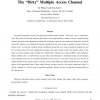Free Online Productivity Tools
i2Speak
i2Symbol
i2OCR
iTex2Img
iWeb2Print
iWeb2Shot
i2Type
iPdf2Split
iPdf2Merge
i2Bopomofo
i2Arabic
i2Style
i2Image
i2PDF
iLatex2Rtf
Sci2ools
CORR
2008
Springer
2008
Springer
The Rate Loss of Single-Letter Characterization: The "Dirty" Multiple Access Channel
For general memoryless systems, the typical information theoretic solution - when exists - has a "single-letter" form. This reflects the fact that optimum performance can be approached by a random code (or a random binning scheme), generated using independent and identically distributed copies of some single-letter distribution. Is that the form of the solution of any (information theoretic) problem? In fact, some counter examples are known. The most famous is the "two help one" problem: Korner and Marton showed that if we want to decode the modulo-two sum of two binary sources from their independent encodings, then linear coding is better than random coding. In this paper we provide another counter example, the "doubly-dirty" multiple access channel (MAC). Like the KornerMarton problem, this is a multi-terminal scenario where side information is distributed among several terminals; each transmitter knows part of the channel interference but the receiver ...
| Added | 09 Dec 2010 |
| Updated | 09 Dec 2010 |
| Type | Journal |
| Year | 2008 |
| Where | CORR |
| Authors | Tal Philosof, Ram Zamir |
Comments (0)

